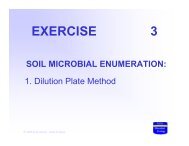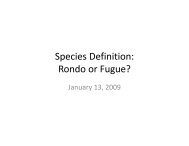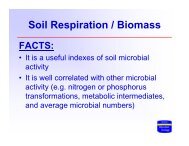Soil Microbial Ecology - Soil Molecular Ecology Laboratory
Soil Microbial Ecology - Soil Molecular Ecology Laboratory
Soil Microbial Ecology - Soil Molecular Ecology Laboratory
Create successful ePaper yourself
Turn your PDF publications into a flip-book with our unique Google optimized e-Paper software.
Page 68<br />
mechanical shaker. Prepare dilutions as in exercise #1 and Plate in bacteria (start at 10 -3<br />
because less soil goes into the first dilution compared with soil dilution lab).<br />
To determine weight of rhizosphere soil, the roots are removed from the original dilution<br />
flask, washed, and the wash water is collected in the original flask. The water is<br />
evaporated and the soil residue is dried to constant weight in an oven at 105-110 o C. The<br />
flask containing dry soil is weighed and dilution factors are calculated, allowance being<br />
made for the amount of soil removed in preparing the dilutions.<br />
Count bacterial colonies at appropriate time intervals during the week and in the<br />
following laboratory session. Describe the morphology of typical colonies. How do<br />
these counts compare to the bulk soil counts in Exercise #1?<br />
2. DIRECT MICROSCOPY.<br />
Obtain 5 roots (< 2 mm diam.) and gently wash to remove excess soil. Place washed<br />
roots in FITC solution (see page 27) for several minutes. Wash roots in sodium<br />
carbonate buffer (5 changes). Cut roots into 1-2 cm lengths and mount in glycerol<br />
adjusted to pH 9.6 with buffer. Observe roots with epifluorescent microscopy (2170<br />
McC).<br />
REFERENCE:<br />
Chapter 2 in Metting's <strong>Soil</strong> <strong>Microbial</strong> <strong>Ecology</strong>





